Tuesday, April 15, 2025
|
You are here: Isle of Man > Attractions > Early Historical Sites > Stone Crosses HistoryMaughold was named after a minor Celtic Saint Machaoi and is believed to have been the main pre-Norse religious community on the Isle of Man. The parish produced the largest collection of crosses and slabs during the early Christian period (6th-13th century). Most found in the churchyard, which was once the site of a Celtic Monastery about 600 AD and three keeills (chapels).The current church goes back to 1000AD to 1100AD, though many alterations and extensions were carried out over the centuries. Much work to modernise the church took place in the early 1900's. At the same time the Maughold Cross House was built. Designed by Armitage Rigby and was the project of PMC Kermode. The finished house was opened in 1906 by the Governor, Lord Raglan. LocationNortheast part of the island, near Ramsey.Map Ref: SC 494 918 By Vehicle: Take the A2 from Laxey to Ramsey, along the way take the A15 to Maughold Village. Maughold church is in this village. By Bus: Take the bus routes no. 3, 3A, 3B or 3C. servicing between Douglas, Laxey, and Ramsey. At Ramsey take the 16 bus to Maughold. By Railway: Take the Steam Railway to Douglas. The Electric Railway to stop Ballajora. Walk to Maughold Village from this stop about a mile away. The Site
At one time every parish church had a cross near its churchyard gate or stile, sadly this is the only one remaining. Made of St Bee's sandstone this cross dates from around 1300 AD. The four sided pillar displays different sets images. One is of the crucifixion with the three legs of man below, two is the virgin and child with a cross and flower below, three is a kneeling figure with an oak leaf above and a square and plant below, four is a oak leaf with a rose above and a chalice below. The three legs of man symbol is the oldest stone carved example of this symbol on the Island. This pillar cross once stood outside the gates of the church, but in 1937 was moved inside the church gates and in 1989 inside the church itself to protect the decaying carvings. No. 11 A slate slab with a plain linear cross upon it. Found on the east side of the churchyard. No. 21 A small slab with a linear cross in a square panel. Found in the churchyard's east keeills. No. 24 A cross with a circular ring. The lower part of the cross extends down. Found as a covering stone for a lintel grave at the churchyard's north keeills. No. 32 A broken slab with the remains of a cross on it. No. 33 A equally proportioned limbed cross with thick limbs and small circles. Found in keeills Woirrey, Cornaa. No. 39 A equally proportioned limbed cross with thick limbs set within a circle. Found near the east gable of the church. No. 40 A large slab with a cross upon it. Found in keeill Woirrey, Cornaa. No. 41 A cross fragment with the remains of a Pattee set within a circle. Above the cross on the right is the Omega symbol, which may have been balanced by the Alpha on the left side of the cross. This is the only example of ] this early Christian symbol on the Isle of Man. Believed to be Anglican work from the late 7th century. Blackman's Cross - Part 1 (No. 42) A rectangular slab with a cross Pattee in a circle. The cross show an early example of triquetra knots decorative work. Below the cross are three small circles with the central one containing a little cross. The upper part of the cross on the surrounding ring has been inscribed in Anglican Runes. The name Blagkmon appears and this could have been the grandson of King Ida of Northumbria, who upon Edwin's Accession was believed to have taken refuge with his family on the Isle of Man. This cross is from around the 8th century. Blackman's Cross - Part 2 (No. 43) A broken slab found near the middle keeill in the churchyard. On one side there is a cross pattee within a circle. Across the lower section are some Anglican Runes, one is the name (Blak)gmon. It is believe that both this slab and No. 42 were put up for Blackman. One part would have been at the foot and the other the head of a grave. The name is saxon, but the style of the slab is Celtic. This cross is also from around the 8th century. No. 46 This slab was from Ballakilley. On one side a cross pattee with curved inward meeting lines within a circle. Irneit's Cross (No. 47) On one side is a six sided cross within a bordered circle, a form derived from the Chi-Rho symbol. There is an inscription in Hiberno-Saxon from the 8th century going around the cross within the bordered circle. The Chi remains, but some of the rest of the inscription is damaged. It is also abbreviated, but reads as follows with the omitted words in brackets: (Ihu) Xp (Ist) I Irneit S(Anctus) P(res)B(iter)I Ep(Isco)p(atu)s Dei Insula >< Apb (Hat)Que. Meaning in the name of Jesus Christ, Irneit, holy priest, God's Bishop in the Island and Abbot. Below the circle are two linear, but formal crosses. At the sides of these crosses are inscriptions reading downwards as follows: In Ih((s)u Xp(ist)i/nomine; meaning, In the name of Jesus Christ and Crux xp(ist)i/imagenem,; meaning, The image of the cross of Christ (I have made in Christ's name an image of the Cross of Christ). These translations show a connection between the early Manx church with Britain and Gaul. The slab dates from around the 7th century. No. 48 A broken slab with a roughly round head. On one side there is a six sided cross within a circle. Below the cross is a small dagger shaped cross. No. 51 A fragment of a cross showing the remains of a Celtic cross and circle within a square like panel. No. 53 A broken slab in two pieces showing a Celtic cross which tapers from head to foot. The limbs of the cross are connected by deep cut circles. No. 55 (Incorrectly numbered No. 54.) A badly worn slab with faint traces of an equal limbed cross bordered by a fine ring. The areas between the limbs of the cross are sunk in. No. 56 Possibly from a keeill near Dhoon. This small slab is broken across the middle, but shows the remains of a cross with ring border. The areas between the limbs are sunken. No. 57 From a keeill in Ballaglass, this small slab has an equal limbed cross within a circle. The lower limb of the cross extends down the shaft, while the other limbs merge into the surround circle. No. 59 A stone in the form of a cross, though partly broken on the right side. arm broken off. Across is a wavy band with two more at the base. There are also five small hollows in a vertical row. No. 68 A slab carved on each side with an Irish form of cross and circle. The top limb extends outside the circle, as does the lower which carries on down the shaft. The two other limbs overlay the circle, but do not extend. All the limbs meet with a circle in the middle. Guriat's Cross (No. 69) From a keeill in Ballaterson comes this large rectangular shaped slab. On one side is a cross extending from the shaft, but overlayed by a circle with another circular boarder. Within the inner circle are five more smaller circles marking out the middle and edge points for the limbs. On the right edge is a short inscription in Hiberno-Saxon reading Crux Guriat. Gwriad, a Welsh Prince, with his family may have sought refuge on Man when dispossessed by his brother Howel, over whom, he was later victorious. This cross is believed to be the earliest Celtic cross in the parish and dates around the 9th century. No. 70 A wheelheaded cross slab which on one side shows an equal limbed cross pattee set in a broad ring. The other side only has a circle and panel. No. 79 From keeill Chiggyrt on Ballafayle this wheelheaded cross slab is carved on one side with a cross pattee within a ring. The limbs have detailed knot work The left limb is decorated with plait of five, the upper and the right with two double triquetra and small circles. The centre of the cross has a ring of plait of three with a smaller ring of twist. Below the circle is a figure with limbs extended out from the body. No. 80 The broke shaft of a large cross. One side key pattern panel, the other has a man with a book and a staff. This could indicate a bishop or abbot. Below the man is a stag. No. 82 A broken and badly worn piece of a cross showing the head of a cross within a bordered ring. There is evidence of plaits of four and the areas between the limbs are sunk in. No. 84 A broken wheelheaded cross shows a circular ring in the centre. The shaft is clear and decorated with thick double twist plaits. No. 86 The lower shaft portion of a cross with a weaved interlacing design. No. 87 A broken piece with the remains of a border and some interlaced design. The radiating lines might suggest that this may have been a sun dial marking the canonical hours. No. 88 A fragment of a slab showing the arc of a circle connecting the limbs of a cross and decorated with plait of three. No. 89 A fragment of a slab show what appears to be a circular ring of plait inside of another circle. No. 90 A large rectangular slab with a large linear cross. The top three limbs are equal in size and end with thicker square like blocks. The bottom limb extends down the shaft. No. 91 The only example of two crosses connecting and sharing one shaft on the Isle of Man. The top, main cross overlays a thick circle ring. The lower cross is less pronounced and has evidence of plait work. No. 96 Rectangular slab with cross overlaying a thick circular ring. Facing the shaft at either side are two seated figures, one appears to be holding onto the cross. Below these figures on each side is a rider on horseback. Below the rider on horseback are fragment figures, which could be hounds. A very worn inscription may have been around the seated figures. No. 97 A rectangular slab broken down the left side. Each face shows a Celtic cross within a circular ring. On one face the cross has a plait of four design which extends into the limbs. To the left of the crosses shaft is a standing figure (possibly a priest). Below the cross are remains of stags pursued by hounds and a huntsman on horseback. On the other side the shaft is bordered by a double bead design. The limbs have a plait of four design. At the side of the cross shaft is a boar being hunted by hounds and below a stag being attacked by hounds. The cross has typical Celtic scroll work. No. 98 A large rectangular slab. One side has a cross with equal limbs up and down, but with very short arms. The cross is bordered with a plain bead design. Above the arms of the cross is a angular key pattern. On the shaft is a figure of the Virgin and Child. On the upper limb is a figure with hands raised in blessing with pastoral staff at his side to indicate a Bishop or Abbot. The figure of a cock, a symbol of the Resurrection, is now almost worn away. The other side is divided into two panels, the space between them decorated with crushed key and spirals. The upper panel is bordered and contains a cross similar to on the other side. Above the right arm is a plain twist design and below looped design. Above the left arm is an unfinished key pattern and below is a plait of three. The lower panel on the left side has two stags and a hound, as well as some scroll work. On the right side is a belted rider on horseback with plait of four below. One edge of the cross has a curved line design with dots (small indentations). The other edge has a key fret design, as well as interlacing rings plait of three with pellets and double spirals all within a border. No. 108 A broken shaft of a cross. One side has a ring chain design and the other side has a panel of double twist and diamond shaped rings within a panel. No. 114 The head of a wheelheaded cross slab carved on both sides. On one side the cross has equal limbs with deep recesses between. Each limb has different plait designs with the arches of the circle being plaits of three and four. The shaft has a ring chain design. The other side has a cross bordered by a cable decoration and plait of eight. The ends of the limbs extend beyond the circles and are decorated with plaits. In the centre, where the limbs meet is a circle and step pattern design. Sigurd Slab (No. 122) This broken cross slab came from a wall in a Ramsey house. One side has interlacing, which is typical of Scandinavian design with broad and narrow bands in the form of a figure of eight. The cross is from around 1150 AD (middle of the 12th Century) and has no Christian symbols. It is one of four Sigurd crosses found on the Island. The others are at Kirk Andreas, Jurby and Malew. The other side of the cross shows a scene from the Sigurd story, which is displays a bolt heaving at an otter as it lay eating a salmon snatched from the pool below. Above this design separated by an interlacing pattern is a later scene of the steed Grani (the grey one) with a gold hoard on his back, which was won by Singuar upon slaying the dragon Fafni. It is possible this cross was made in memory of King Olaf, who was slain at Reamey in 1153. No. 133 A fragment from a keeill at Ballagilley and shows the front part of a boar. A well carved flat design believed to be from the Norse period. Hedin Cross (No. 142) A badly broken slab from a lintel grave at the north keeill. On each side is a Celtic cross design without a circle. The decoration is not very good, but there are good cut runes. The shaft has a step pattern design with cable moulding borders. This work may suggest Anglican work. On one side below the right arm of the cross is a Viking Ship. The only example on the Isle of Man. The inscription reads: Hedin: seti: krus: thina: after: tutur: sino Lif, meaning Hedin set this cross to the memory of his daughter Hlif. On the other face is a short inscription on the right side reading: Arni: risti: runar: thisir, meaning Arni Carves these runes. Iuan (John) Priest's Slab (No. 144) A broken slab piece from around 1200 AD found in keeill Woirrey at Cornaa. It has an inscription including Christ and three great Celtic saints. It reads: Kristh: Malaki: ok: Pathrik: Athanman. iinal: sauthar: Iuan: brist: i Kurnathal, meaning Christ, Malachi and Patrick (and) Adamnan! But of all the sheep Iuan is priest in Cornadale. Iuan's (John's) Church Stone (No. 145) This slab has been broken across the middle and was found at the parish church around 1900 AD. It has an inscription cut at a later date by same Iaun as in slab No. 144. The inscription reads: (I)uan brist raisti thisir runur, meaning Juan Priest cut these runes. This inscription is followed by a line in the runic alphabet reading: Futhork hnias tbml. The third line gives the alphabet in Ogam characters reading: Blrsn hdtcq (mg ng st r aouei). This stone may have been built into the wall of the church, so that all might see and learn the use of letters. No. 149 A tiny fragment from a wheelheaded cross. The arm of the cross is adjoined by a small section of a circular ring with a double beaded plait of six design. Believed to be Scandinavian. Branhui's Cross (No. 169) A broken slab with the remains of a square armed cross with sunken recesses between each arm. The inscription reads: Ihs(u) sp(i)s(ti)/branhui/huc aqua/diriuauit, meaning (In the name of) Jesus Christ, Branhui led off water to this place. The other side of the slab has a simple cross within a double circle. There is some later Viking graffiti forming an inscription and knot. Branhui is a Welsh name and this Monk provided his Celtic monastery with Water. (The original stone was found in 1948 and is located in the Manx Museum.) No. 175 This slab was found in Maughold in 1965. It has a Runic inscription from around 1100 AD (12th Century) which translates to: 'Kuan son of Mailb... ak... made this grave stone to the memory of his wife.' (Cast). No. 190 A broken slab which has circles enclosing a Maltese cross on one side. Related News Articles
|
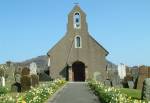 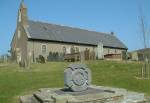 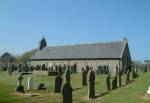  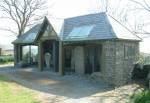 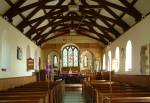 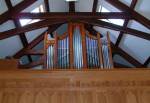 |
|
Other Guides by Maxima Systems Ltd: Disney World
